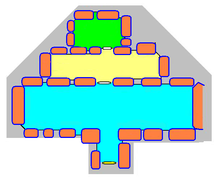Hvisselhøj
Hvisselhøj (also Vissehøj or Visihøj) is a 1915 excavated passage grave ( Danish Jættestue ) with three chambers arranged in parallel. Its construction is unique and only has a counterpart in Malta . It is located in Han Herred , in an intact mound, north of the Limfjord on Alsbjergvej near Attrup on the island of Vendsyssel-Thy in Denmark .
It is a megalithic system of the funnel beaker culture (TBK) that was created in the Neolithic Age (3500–2800 BC ). The passage grave is a form of Neolithic megalithic systems, which consists of a chamber and a structurally separated, lateral passage. This form is primarily found in Denmark, Germany and Scandinavia, as well as occasionally in France and the Netherlands. Neolithic monuments are an expression of the culture and ideology of Neolithic societies. Their origin and function are considered to be the hallmarks of social development.
description
A narrow passage leads into the first chamber, which is about 8.0 m long and 1.5 m wide. A narrow, centrally located passage leads into the secondary chamber, which is less than 6.0 m long and almost a meter wide, which in turn is connected by an even smaller opening to the tertiary chamber, which is a little more than two meters long and a little more than a meter wide in the middle .
- Chamber 1 has five cover stones and 15 bearing stones
- Chamber 2 has seven cover stones and 11 bearing stones (four of them together with Chamber 1 and three with Chamber 3)
- Chamber 3 has two decks and eight bearing stones (three of them together with Chamber 2)
The excavation of Hvisselhøj revealed that the three interconnected chambers were built at the same time. The prehistoric construction was secured during the restoration with iron girders, which were replaced by stainless steel in 1998. Passage graves with two adjacent chambers ("dobbeltjættestue") are not so rare in Denmark ( there are three in Skåne ).
See also
literature
- Peter V. Glob : prehistoric monuments of Denmark. Wachholtz, Neumünster 1968 p. 72
Individual evidence
- ^ Johannes Müller : Neolithic Monuments and Neolithic Societies. In: Hans-Jürgen Beier , Erich Claßen, Thomas Doppler, Britta Ramminger (eds.): Varia neolithica VI. Neolithic Monuments and Neolithic Societies. Contributions from the meeting of the Neolithic Working Group during the annual meeting of the North-West German Association for Ancient Research in Schleswig, 9. – 10. October 2007 (= contributions to the prehistory and early history of Central Europe. Vol. 56). Beier & Beran, Langenweißbach 2009, ISBN 978-3-941171-28-2 , pp. 7-16, here p. 15.
Web links
- Description and picture
- / Description and floor plan
- Hvisselhøj on Grosssteingraeber.de
Coordinates: 57 ° 3 ′ 27.6 ″ N , 9 ° 26 ′ 49 ″ E

